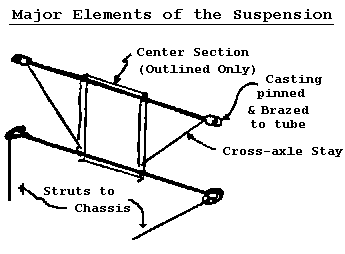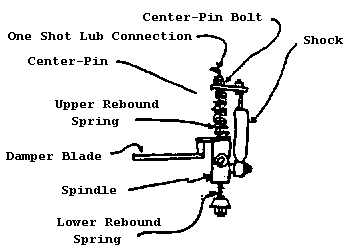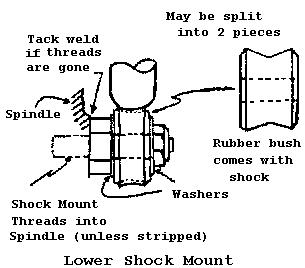It's What's
up Front that Counts (!) or The Care and Feeding of your Morgan Front suspension
by Gerry Willburn & Lorne Goldman
The basis of this
article (containing more than you ever wanted to know about front suspensions)
was written by Don Morrill in 1971 and is presented here with many changes,
updates and added sections.
Introduction
A high wear point
on the Morgan, and believe it not not, there are a few,
was/is the brass
bushings that are pressed into the front wheel spindles with the older
mild steel kingpins or the Factory's stainless steel kingpins used when
with DEVOL bushes. To check for wear, jack up the front end and have
someone
wiggle the front wheel about the horizontal (hold the top and  bottom), and look for movement of the lower end of the spindle with respect
to the lower rebound spring. Bushing wear results in a certain vagueness
in steering, and a feeling of front end looseness, but otherwise is not serious
except in the extreme. Wheel shake is not
cured by re-bushing. Although the shake may disappear at first, when
the bushings wear in the shake will return. Wheel shake is usually
caused by loose damper blades or square wheels. If you want a forever
front in this area, switch to Hardchrome kingpins, used with ANY bush material you choose.
As of this date (09/2020) the Factory has refused to adopt Hardchromes
despite their impeccable reputation and LONG history. As they have now
abandonned the legendary 110 year Morgan classic completely, that is
all she wrote.
bottom), and look for movement of the lower end of the spindle with respect
to the lower rebound spring. Bushing wear results in a certain vagueness
in steering, and a feeling of front end looseness, but otherwise is not serious
except in the extreme. Wheel shake is not
cured by re-bushing. Although the shake may disappear at first, when
the bushings wear in the shake will return. Wheel shake is usually
caused by loose damper blades or square wheels. If you want a forever
front in this area, switch to Hardchrome kingpins, used with ANY bush material you choose.
As of this date (09/2020) the Factory has refused to adopt Hardchromes
despite their impeccable reputation and LONG history. As they have now
abandonned the legendary 110 year Morgan classic completely, that is
all she wrote.
To gain familiarity
with the front suspension, sketches are provided that show things ex-works.
If your car has been repaired due to front end damage, a check is worth while
to determine if everything is there, and properly installed. Most body shops
are relaxed about keeping track of attaching hardware, so some imagination
might have been exercised during assembly. Most of the suspension hardware
is Whitworth and holes are sized for the English bolts (Ed. later cars '70
on are metric). If American Standard has been substituted, additional hole
clearance will result.
Check for missing
parts. As Mr. Morgan is not known for using two bolts where one will do,
if your car is missing anything, the results will catch up. Make sure the
shocks are secure at both ends, that the damper blades are intact, that chassis
stays are tight, and the center pin bolt and nut are tight. Have someone
rock the steering wheel about center and check for vertical motion of the
steering drop arm (See Morgan Owners Manual -- the one that should come with
the car) or motion of the damper blade components. Make sure the damper blade
is sandwiched between chassis and metal strip but can move freely. Older
(Drum Brake) Morgans do not have this aluminum spacer as shown.
The spacer is mounted
on the chassis Z-section but serves the same function.
Areas That May Require Attention to Stop Vibration (revisited 2020)
There are so many things that can cause vibrattion with a
Classic Morgan that we prejudice a cure if we run to the front
components only in trying to determine the cause. In 25 years and with
an average quyestions and reports coming in volume during that time, I
have seen so many causes of this experience. Symptoms and
circumstances are of key importance when search for the reasons. When
is happening, in terms of rpm and speed and gear selected?
 1. Shock absorber replacement
or Adjustment
1. Shock absorber replacement
or Adjustment
2. Upper shock bracket
replacement
3. Damper blade adjustement
or replacement
4. Front wheel bearings
and Installation
5. Kingpin
and bushing replacement
6. Cross-axle
stay adjustment
7. Wheel Cracks
8. Wheel Balancing I
Balancing II
Balancing III
9. Wire
Wheels Need to be Trued
10. Checking the Tyres
11. Tyre Tread Patterns and
Wear
12. An Unwise Modifcation
(you have installed an "enhancement" that has prejudiced your front end)
13. Brake problems
'
14. Faulty Ignition Timing (yes..if the ignition timing is too advnaced or retarded it can create a vibration easy mistakeable for something else)
15. Propshaft Unbalanced or Out of Phase or U-Joints Failing
16. Clutch, Gearbox or Axle Anomally
17. The Newer Morgan Silencers (post 2010) Can Cause Vibration at Certain rpm or mph
18. Steering Components
Shock absorber replacement
Use two 9/16" open
end wrenches to remove the two nuts at the top of the shock (one nut is used
as a jam nut).
Push shock strut into
the body of the shock.
Remove the 5/8"-W
nut at the bottom shock mounting stud.
Work off the shock
Access for shock replacement
is by jacking up the front end and removing the wheels.
I suggest putting
a light coat of chassis lube grease on the rubber fittings at the bottom
of the shock so it moves easily on the mounting stud.
Replacement Shocks (Front only)
| MANUFACTURER |
PART # |
COMMENTS |
| AVOs (Rutherford) |
N.B. There are three types of AVOs sold for Morgans
RUTHERFORD AVOs
available from NewElms Morgan and Heart of England Morgans
|
adjustable
MOST RECOMMENDED |
| Koni |
80-1021 |
adjustable at installation
only as
Adjusting feature is compromised after the first time the vehicle
bottoms out.
RECOMMENDED |
| Spax |
G155 HJ |
gas & adjustable |
*N.B. You will need
to change or modify the bottom bushings by drilling them out to 5/8 inch.
You can also use Energy Suspension poly urethane bushes #9-8113
which are a 2 piece affair.
Replacement Shocks
(Rear only)
| MANUFACTURER |
PART # |
COMMENTS |
| AVOs (Rutherford) |
N.B. There are three types of AVOs sold for Morgans
RUTHERFORD AVOS
Available through New Elms Morgan and Heart of England Morgans.
INDICATE what model and year and whether there has been a retro-fitted rear
suspension as there are two different lengths that may be applicable
(recommended)
|
Made for Morgans
adjustable for a short period
RECOMMENDED |
| Spax (all Morgans) |
G464 HN (now G319) |
gas &
adjustable |
| Koni (1961-5/91) |
80-1573 |
adjustable at installation
only |
Koni 4/4,+4 +8
(6/91-?) with telescopic
rear dampers
only if distance between top and bottom attachments is 265-290 millimetres |
80-2725 |
adjustable
RECOMMENDED |
Webmaster N.B.
I have noticed that some of the part numbers may no longer be valid. The Spax, Koni and
Monroe numbers are likely current but double check on purchase.
Upper Shock
Bracket Replacement Remove the shock from the top attachment
(bracket) as above. Remove bolt that holds fender
brace and bracket to upper cross-axle (this may be hard due to limited access
at lower end); Wrench size is 1/4"-W, Open-end.Use 3/16"-W open-end wrench
to remove one-shot lube fitting from the center pin bolt.Use 7/16"-W wrench
to remove center pin bolt and free the Shock Mount Bracket

Lower Shocks And
Brackets
Access as per Shock
removal, but cross-axle must be resting on support, front wheels off the
ground, to prevent the center pin from separating from the upper cross-axle.
Car must not be moved with the center pin bolt removed. You can have the
broken bracket welded or purchase one from Club Spares, or from Isis Imports,
or from England. (Ed. Or check the list of suppliers in the Suppliers and
Cross-reference article on the Morgan Web page).
Proper Adjustment of Front Shocks Fasteners (the effect of over-tightening)
Joe Phillips from the ThamesMog site 1997
Have you just had
your Kingppins done or front shockers replaced? Are you unhappy with the
feel?
Look to your
shocks.
It is very possible the securing nuts have been over-tightened.
(Alternatively, the clearance between the Kingpins and the
bushes is insufficient and for that you should check the Front
Suspension section.) Over zealous tightening of the shock absorber's
mounting nuts (top or bottom) can ruin the
ride and handling. To cure over squeezed bushes, you do not have to
take the wheels off or jack the car. Very common for amateurs and
non-Morgan mechanics. After having the Kingpins and bushings done the
ride and
feel just wasn't right. In fact it was terrible. There was no play in
the
KingPins or wheel bearings, yet all seemed in order.
I solved this problem
by checking the rubber grommets on the mounting at the top where there are
two nuts, one a lock nut. Whilst it is obviously important they are securely
tightened, it is not necessary to squash the rubber grommets/bush down as
far as it will go, i.e. bulging out at the sides under high pressure. The
installer had done the both nuts up as tight as possible squatting the rubber
grommet till the whole unit was solid. Mine were squashed so hard by the
securing nut that the rubber was solid and ineffective. Mine are SPAX but
this applies to other makes.
| This can happen
with shocks nuts, top and bottoms, front or back. The nuts should be tightened
only to point the rubber is not crushed and/or bulging out and the shock itself
can be still be turned a bit by hand. LG |
Proper Adjustment of Front Shocks (how many nods are perfect)
by Lorne Goldman November 2017
It is
sad to see so much basic knowledge lost in such a short time. I
currently see so many owners spending huge sums to correct
problems that proper maintenance or adjustment could cure more functionally in minutes.
Current forums seem to have lost once-valued expertise and
lore. :(
There seems to
be a new infatuation with front end "nodding" as in how much nodding is
"perfect" and how much money should be invested to create the perfect
nod number. (giggle) That is an easy question to answer. 1 and 1/2 front nods! Of
course, over time, your front end will deteriorate..depending
on your springs (main and rebound), your maintenance, your driving
style, the extent of your usage, your Morgan arena/environment, your
tyres, your usage and your shock type. (shrug) I have found that adjustable
shocks will extend the front end life a bit...but only on occasion and with certain types of shocks.
WATCHPOINT: "Adjustable"
shocks is a widely misunderstood feature. Too many owners are convinced
they are made so as to afford owners a fine tuning feature for
different vehicle uses and conditions. THAT IS NOT TRUE. Adjustability
merely makes stocking easier for the manufacturer and their
distributors. Shocks must be chosen for a certain length, extension distance and dampening rate. The first two cannot be adjusted but the dampening rate can, at least for a short period of usage normally until the first bottoming out. So why make many shocks for the same length and extension? Just
add a simple feature to change the dampening rate. This is not
explained by most shock manufacturers and sellers but many of them will
thankfully adjust the rate to the buyer's car before shipping assuming
they know what car they are selling to.
Of course, that little valving won't survive long. KONI, one of the
best, speculated to me that their adjustment feature is gone after the
first hard bump. It can be repaired, but the shocks must be
returned to KONI. Rutherford
tells me his AVOs' adjustability he had designed disappears with usage
as well. But if the shocks have been adjusted properly, who cares?
The only tragic thing is if you have badly adjusted "adjustable" shocks
and the feature is destroyed in that wrong setting. I have known that
to happen, making the shocks unbearable, far too firm or far too soft. |
BACK
 bottom), and look for movement of the lower end of the spindle with respect
to the lower rebound spring. Bushing wear results in a certain vagueness
in steering, and a feeling of front end looseness, but otherwise is not serious
except in the extreme. Wheel shake is not
cured by re-bushing. Although the shake may disappear at first, when
the bushings wear in the shake will return. Wheel shake is usually
caused by loose damper blades or square wheels. If you want a forever
front in this area, switch to Hardchrome kingpins, used with ANY bush material you choose.
As of this date (09/2020) the Factory has refused to adopt Hardchromes
despite their impeccable reputation and LONG history. As they have now
abandonned the legendary 110 year Morgan classic completely, that is
all she wrote.
bottom), and look for movement of the lower end of the spindle with respect
to the lower rebound spring. Bushing wear results in a certain vagueness
in steering, and a feeling of front end looseness, but otherwise is not serious
except in the extreme. Wheel shake is not
cured by re-bushing. Although the shake may disappear at first, when
the bushings wear in the shake will return. Wheel shake is usually
caused by loose damper blades or square wheels. If you want a forever
front in this area, switch to Hardchrome kingpins, used with ANY bush material you choose.
As of this date (09/2020) the Factory has refused to adopt Hardchromes
despite their impeccable reputation and LONG history. As they have now
abandonned the legendary 110 year Morgan classic completely, that is
all she wrote.
 1.
1. 